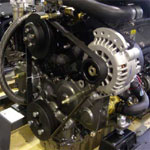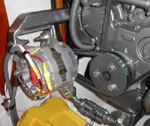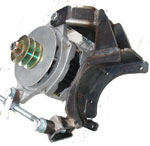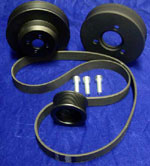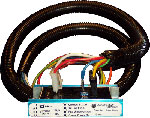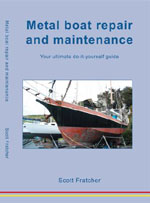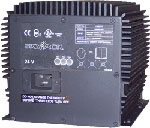 |
|
|
|||||||||||
|
Reducing marine noiseorMarine Sound AttenuationSound attenuation, or reducing the onboard noise is often considered an art. The industry has progressed to a state that boat crews often step outside from their cabin only to realize the vessels engines are running and she has already left the dock. This has been a problem in one instance where a crew member fell overboard and was not heard by the remaining crew inside their “bubble” of near silent boat operation. Reducing the noise aboard a vessel is done for many reasons.
The ability of the crew to effectively communicate can be correlated to amount of background noise.
Start at the sourceThe number one source of background noise inside a vessel is vibration induced by machinery into the boat structure which radiates through the hull. This is important as many of the commonly thought of noise reduction techniques will not produce the “attenuation” expected if this conduit of sound is not reduced. To put it simply- Conventional insulation will not control noise once it is in the hull. Let’s look at a extreme example of diesel engine installation rigidly mounted to the engine rails. This is of course the strongest, and most dependable engine mounting system and often used by commercial vessels. It’s also about the loudest installation possible.
Diesel engines produce a low frequency vibration that is notoriously difficult to control. In a rigidly mounted engine (or other device IE Air con, pumps etc) the vibration is directly transferred to the hull. On a diesel engine the solid mounts picks up the vibration and transfers it to the hull that acts as a drum releasing the vibration energy all through the vessel as audible noise.
Therefore, the first rule of reducing noise in a vessel is to vibration isolate anything attached to the hull. This is why modern engine manufacturers all use rubber engine mounts. These mounts are specifically designed to reduce the vibration transferred into the hull making their engines “sound” quieter to the end user.
Exhaust systemThe engine is the obvious noise maker and rubber engine mounts help considerably but to produce a truly “attenuated” propulsion system we must look at the complete picture. The often overlooked noise culprit is the exhaust system. The exhaust system stretches through the boat like a giant tuba radiating unpredictable noise. Every connection between exhaust and the hull should have a vibration mount. High performance mufflers should be added to reduce sound - water mufflers and traps are ideal.
Drive TrainThe drive train should incorporate a noise reduction protocol. The first step in reducing drive train noise is to reduce the drive train vibration, so there is less pulsation to radiate to the hull. Tricks to reduce drive train noise are-
* Use a specialty dampener plate (such as sold by PYI) to connect
the engine to the gear box
Dampener Plate and couplingMost small engines arrive with a basic dampener plate that is mounted on the back of the flywheel that accepts the input shaft of the gearbox. This plate has a stack of springs that control variances in torque and minor misalignments. Companies such as PYI make specialty dampener plates that help control drive train noise.
A flexible coupling between the gearbox and prop shaft reduces gear chatter transferred into the prop shaft that can escape as noise.
Shaft alignmentTo reduce prop shaft noise the engine and drive train must be in perfect alignment and balance. Often we hear the engine should be aligned to the prop shaft within .005” of an inch, but this does not take into consideration the alignment between multiple cutlass bearings, and the packing gland. Use a laser alignment tool to check installation and produce perfect results.
Quiet the propA propeller can transfer noise into the hull especially because the cutlass bearing is normally rigidly mounted directly to the hull. Therefore any propeller or shaft vibration will transfer straight into the hull to re-radiate as noise.
The first step to quieting a prop is to have it professionally balanced. Stuart Camp of Marshall Day Acoustics tells us, “Nobody would put new mag wheels and tires on their car without balancing them. The same philosophy should apply to a new boat prop.”
Propellers are designed to turn torque into thrust and that transfer of energy can release a large amount of vibration. One of the first steps to reduce prop noise is to consider the water flow. Obstructions such as zincs, thick deadwood, or fat leading edges of the rudder can produce vibration and cavitation.
Cavitation is not just destructive to surrounding metal it is also loud. By concentrating on producing a smooth water flow over the prop efficiency is increased and noise is reduced.
Vibration mount everything that vibratesA common idea on boats is that everything needs to be tough and strong. Dockside advice tells us “through bolt and tie down anything that can move,” but this process also transfers noise into the hull to re-radiate. For this reason we seek methods of preventing the noise from entering the hull. This can be done with special vibration mounts, hanging spring mounts, and restrained mounts.
Restrained mounts allow the mechanical system to move, but prevents excessive movement. In other words we can hang an exhaust system but we don’t want it so loose it falls off the wall. Restrained mounts were designed with this in mind.
Advancements in noise reductionThe super yacht world has made some of the biggest advancement in noise control. Whole cabins are built into the hull on vibration mounts. It should be noted the noise that is prevented from entering and leaving the cabin is high frequency vibration like footfalls, and voice while engine noise continues to penetrate. Engine noise is a difficult vibration to control and cabins mounted on vibration mounts still “hear” the engines. Often the owner’s cabin is mounted in the aft end of the boat. This may be the most comfortable for sea motion, but due to drive the train passing underneath it’s often the loudest.
Noise reduction decisionsThere is a balance between three forces in noise control. They are- * Weight Super yachts often consider space the most important while cost is the least. Race boats may consider weight the most critical item while space is not so much an issue. Many race crews will forgo any noise suppression in to save weight.
Earthrace is a classic example. To save weight in the round the world record attempt all noise control was forgone. While operating at speed the noise level inside the cabin approached a jet engine at take off. After sixty days at sea the crew were suffering from cauliflower ears due to the continual use of noise canceling headphones.
Ventilation pathsVentilation systems such as ducting lets noise in and out. Consider a well sealed engine room door that is opened a crack allowing a large amount of noise to escape. If an engine room duct were installed that were simply a hole in the door the same noise would escape.
To prevent noise from escaping the ducting- * Rout the duct in a convoluted path,
Absorption vs. BarrierSound is best contained at the source, but once loose it must be contained by absorption and barriers. Absorption materials are foams and other type materials that dissipate sound energy, largely as heat. Barriers are dense materials that tend to dampen the sound preventing it from passing through.
Note-Acoustic plywood is an interesting noise control material. It takes a moderate sound barrier (plywood), and increases its mass by adding a flexible sound barrier in the middle, and at the same time reducing its overall stiffness - both techniques being fundamental to good noise control.
Dampening paintFundamentally, dampening is done by adding mass. The trick is to add the least amount of mass in the most effective location to gain maximum return for minimum weight. Dampening paint is available that can coat areas of the hull where sound enters. Another layer is added to areas that radiate sound to produce a one two punch in sound attenuation. However, don't get caught in the trap of adding a tiny amount of mass to a very heavy panel - it makes no difference!
Uses of dampening paint include * Engine rails
Remember the #1 Rule-Prevent sound from leaving the source first and block the transmission path second.
Aircon/refridgerationAir-conditioning and refrigeration systems pose a special challenge because they tend to run at all hours weather at anchor and while at sea. At the most quiet time of night the air conditioning system is still vibrating away.
To quiet an air-conditioning system start at the compressor. It should be mounted on vibration isolation mounts. All cooling lines, pumps, and relay boxes should be hung with vibration mounts. The ducting should be coated inside with a sound absorbing material and ideally the mounting of the ducting should be on vibration hangers. In critical situations, the inside of the ducting can also have a series of baffles turning the duct into a type of muffler to prevent the fan noise from transferring down the duct. Note: Sound absorbing linings inside ducts are generally porous, and
can therefore accumulate lint, dust and mould. Careful selection of
materials is therefore critical. Very thin metalised facings (20 microns
thick or less) can sometimes be used to give a cleanable face without
significant reduction in acoustic performance. Return ventAn often overlooked area of noise reduction is the return vent of the air-conditioning system. The supply duct may have baffles and well thought out suspension, but the system inlet or room vent may be nothing more than a louver. This is slightly better than no noise suppression at all. Consider at least a sharp turn in the ducting.
Galley and laundry roomTo quiet the exhaust blower from the galley or laundry the same systems must be incorporated as an air-conditioning duct, but the galley exhaust system must also be fire proof.
Active noise controlActive noise control involves producing a “reverse wave” that deadens the noise in a specific area. Active noise control is the last step in attenuating noise and should not be thought of as a solution to living in a loud space. Active noise control only works in a small localized area. Noise canceling headphones work well because the area covered is the area around your ears. Active noise control would not work for a larger space such as an engine room.
Stuart Camp of Marshall Day Acoustics says “Some cars now come equipped with noise canceling technology to surround the area around the passengers head. If they bend down to tie their shoelace the noise level increases.”
Tip-When installing engine room foam the heavy barrier inner layer of sound deadening material should contact or even overlap the barrier in the adjacent sheet. This means making a notch into the form so the connecting deadening material will directly butt against the next barrier layer. This prevents a line of noise from escaping.
Tip-All doors to a loud space should be sealed with a sound deadening strip. We all know the amount of sound released from an engine space when we simply “crack” the door open. Often the biggest return for engine room noise reduction comes from simply putting weather stripping around the engine compartment doors preventing direct noise transfer through the gaps.
Outboard motorsOutboard motors can be mounted on sound reducing blocks bolted to the transom. The bonit/cover can have a thin layer of sound reducing material fitting inside. Pay particular attention to the air flow paths so we don’t starve our outboard for air.
Dry exhaust systemsMarine dry exhaust systems receive a great benefit from advancements made on land. Detroit Diesel engines can considerably reduce the “fisherman whine” by using a Cowl muffler. The Cowl muffler is designed specifically for each model of the Detroit line and “spins” the exhaust noise to produce an amazing muffling effect.
Four stroke engines can benefit from a hospital grade muffler. Although large, they have the greatest noise reduction effect.
The dry exhaust system should be wrapped to reduce heat transfer, fire threat, and noise escaping. In today’s world, dry exhaust lagging can be purchased to directly fit most weld on elbows. This makes for a quick professional finish to a welded dry exhaust system. Remember to use isolation mounts on the support of the dry exhaust system.
FutureThe future of noise suppression will be in bow thrusters, winches, and hydraulics.
Winches are noisy and directly bolted to the deck so they re-radiate the noise through out the boat. This is a difficult problem for the engineers as we don’t want a winch to flex under load, but we also need to isolate the noise. Advancements are being made in gear mesh that reduces the contact noise.
Bow thrusters are rigidly mounted to the hull and are a near perfect sound resonator. In one case a charter boat galley was built above the aft thruster. The galley crew was required by inspecting authorities to wear ear protection during docking operations.
Advancements will come from more efficient propellers that do not cause the vibration typically heard with large thrusters.
Hydraulics are particularly difficult as the pipes flex due to the high pressure. As the industry advances so do the high pressures. Common rail diesel injection systems now run at 30,000 psi. This pressure rise is making an even greater challenge for sound engineers. Advancemans will come from specialty hoses that reduce vibration while accepting the extreme pressures.
|
||||||||||
| © Team Yachtwork 2007 | |||||||||||
